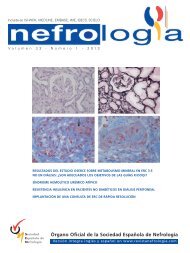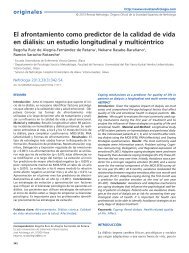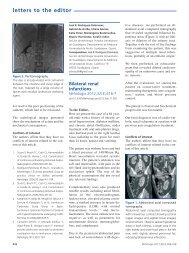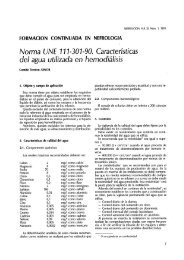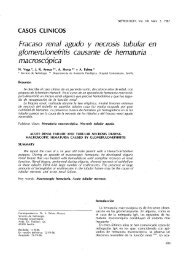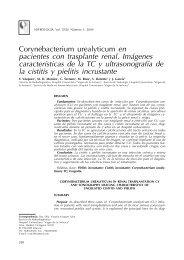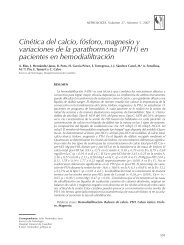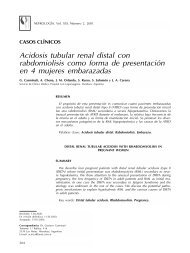PDF Número - NefrologÃa
PDF Número - NefrologÃa
PDF Número - NefrologÃa
You also want an ePaper? Increase the reach of your titles
YUMPU automatically turns print PDFs into web optimized ePapers that Google loves.
guías S.E.N.<br />
I. Berdud et al. Anexo a la Guía de Centros de Diálisis<br />
centre directly. The results and reports from these<br />
interconsultations should also be sent to the centre. It<br />
would also be best if the reference hospitals and their<br />
private dialysis centres shared common treatment<br />
protocols. These protocols should include basic aspects<br />
of the treatment of renal patients (anaemia, mineral<br />
metabolism, vascular accesses including catheter<br />
infections, etc., and laboratory tests), transplant<br />
protocols, complementary tests, and other components<br />
specific to each area. Not only would this generalise<br />
and unify the approach taken with dialysis patients<br />
regardless of where they are treated, it would also<br />
facilitate access to data on all patients regarding<br />
clinical trials and research studies. Access to<br />
medication. Dialysis patients require medications that<br />
are only given in the hospital setting, which is normally<br />
provided by the reference hospital, as per the<br />
agreement between institutions. It would also be<br />
recommendable that any other medications not<br />
included in the agreement (antibiotics, urokinase,<br />
nutritional supplements, etc.) be dispensed in a similar<br />
manner. Access to kidney transplant. The management<br />
of the transplant waiting list, once a patient starts<br />
renal replacement therapy, should be controlled from<br />
the dialysis centre, as in any other procedure. As such,<br />
the nephrologists from each centre should be familiar<br />
with the existing protocols and new developments in<br />
this context, and should participate in meetings with<br />
nephrology and urology departments in each hospital.<br />
The transplant protocol at each town/region should be<br />
followed for all patients, whether dialysis is undergone<br />
in a hospital or private centre. Characteristics of the<br />
work at dialysis centres. The doctor attending patients<br />
at each dialysis centre must be a specialist in<br />
nephrology. This complicated issue must be a<br />
requirement for agreements within the regional health<br />
system in order to guarantee a proper and equitable<br />
treatment of patients that receive dialysis in private<br />
centres. Only in the case of an absence of a<br />
nephrologist should a general practitioner be used, and<br />
this doctor must have adequate training in<br />
haemodialysis. This training should also be<br />
standardised. Over 75% of nephrologists that work at<br />
these centres are alone during the workday, and 40%<br />
never see another colleague during the whole shift.<br />
The administrators of these centres should seek out<br />
protocols that provide professional contact, both with<br />
the hospital staff and nephrologists from other centres,<br />
which would facilitate an exchange of ideas. Training.<br />
The nephrologists at each centre have the right and the<br />
obligation to perform research and to continuously<br />
expand their training, so as to develop and improve<br />
health care provision. Since the majority of patients in<br />
haemodialysis programmes are treated in outpatient<br />
centres that depend on reference hospitals, we might<br />
suggest a minimal rotation of nephrology residents in<br />
private outpatient dialysis centres, once accreditation<br />
has been given for providing this training.<br />
Keywords: Haemodialysis. Dialysis centre. Hospital. Clinical<br />
guidelines<br />
666<br />
INTRODUCCIÓN<br />
Desde los inicios de la hemodiálisis en España en 1957, la<br />
diálisis en el ámbito privado ha estado presente como consecuencia<br />
de la escasez de plazas en los hospitales públicos. En<br />
la actualidad, un gran número de pacientes pertenecientes al<br />
sistema público de salud reciben hemodiálisis en centros extrahospitalarios<br />
y son atendidos por un grupo también numeroso<br />
de nefrólogos que desarrollan su actividad profesional en<br />
estos centros. En algunas ciudades, los pacientes tratados<br />
en los centros extrahospitalarios son, en número, más de los<br />
que son sometidos a diálisis en los hospitales de referencia.<br />
Por otra parte, y a diferencia de lo que ocurría en el pasado,<br />
actualmente, la mayoría de los centros de diálisis extrahospitalarios<br />
pertenecen a compañías multinacionales que tienen<br />
establecidos estrictos programas de gestión de calidad que<br />
controlan todos los procesos del tratamiento de diálisis. Para<br />
garantizar la equidad en el tratamiento de estos pacientes respecto<br />
a los tratados en los hospitales, estos centros tienen concertados<br />
los servicios con las delegaciones de salud de las distintas<br />
Comunidades Autónomas en todo el territorio nacional.<br />
Las condiciones del concierto añaden más control al tratamiento<br />
de los pacientes en diálisis. De esta forma, se deberían revisar<br />
estas condiciones para que los estándares de calidad como<br />
agua ultrapura, hemodiálisis de alto flujo, incluso técnicas convectivas<br />
como la hemodiafiltración on-line estuvieran al alcance<br />
de los pacientes, también, en los centros concertados.<br />
Las distintas guías de actuación clínica promovidas por la Sociedad<br />
Española de Nefrología (S.E.N.) 1-5 , así como la creación<br />
de indicadores y estándares de calidad asistencial en hemodiálisis<br />
por parte del Grupo de Gestión de Calidad 6 , pretenden homogeneizar<br />
el seguimiento del paciente renal. Sin embargo,<br />
esta labor de homogenización se ve dificultada, entre otras<br />
razones, por la existencia de distintas compañías de diálisis,<br />
con centros ubicados en distintas ciudades, con distintos hospitales<br />
de referencia y distintos criterios de actuación en función<br />
de los conciertos existentes con la sanidad pública que<br />
difieren también entre las diferentes Comunidades Autónomas.<br />
Una buena relación del centro concertado con su hospital<br />
de referencia permitiría conseguir la igualdad en el tratamiento<br />
del paciente sometido a diálisis, al menos en esa<br />
localidad.<br />
Con el objetivo de homogeneizar el tratamiento de los pacientes<br />
sometidos a diálisis en centros concertados, se creó,<br />
hace ya más de 10 años, el Grupo de Diálisis Extrahospitalaria<br />
de la S.E.N. La actividad fundamental del grupo ha sido<br />
promocionar la formación continuada de los nefrólogos que<br />
trabajan en centros concertados, así como investigar, analizar<br />
y divulgar la situación de los distintos centros en un intento<br />
de mejorar y actualizar las condiciones de tratamiento<br />
sustitutivo renal de los pacientes. Con ese objetivo se han hecho<br />
sucesivas encuestas 7,8 y reuniones anuales para compartir<br />
experiencias de los nefrólogos extrahospitalarios.<br />
Nefrologia 2011;31(6):664-9



